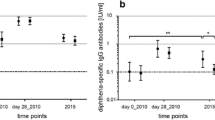Summary
Large outbreaks of diphtheria occurred recently in the former USSR. Between 1989 and 1994, a total of about 600,000 Soviet immigrants arrived in Israel. The immune status against diphtheria in a sample of 992 men aged 17–49 and 195 women aged 17–19, who arrived in Israel during 1990–91, was studied in order to evaluate the need for vaccination. Participants completed a self-administered questionnaire and diphtheria antitoxin antibody levels were measured by means of ELISA. At age 17–19, the prevalence of antitoxin antibody levels below the protective level of 0.01 IU/ml was 4.8% in the men and 2.1% in the women. Among the men, the percentage lacking protection declined from 4.8% at age 17–19 years to 1.6% at age 20–24, and increased to 18.2% at age 35–49. In the oldest group, the prevalence of those lacking protection was considerably higher than for the general Israeli population. In the multivariate analysis, age, mother's education and republic of origin were significantly associated with the absence of protection. Immigrants from the former USSR appear to be more susceptible to diphtheria, thus increasing the possibility of clinical disease, and it is recommended that they receive booster doses of diphtheria toxoid.
Similar content being viewed by others
References
Diphtheria in the New Independent States of the former Soviet Union. CDR Wkly. 5 (1995) 229–232.
Diphtheria epidemic—new independent states of the former Soviet Union, 1990–1994, MMWR 44 (1995) 177–181.
Galazka, A. M., Robertson, S. E., Oblapenko, G. P.: Resurgence of diphtheria. Eur. J. Epidemiol. 11 (1995) 95–105.
Galazka, A. M., Robertson, S.E.: Diphtheria: changing patterns in the developing world and the industrialized world. Eur. J. Epidemiol. 11 (1995) 107–117.
Cohen, D., Katzenelson, E., Green, M., Slepon, R., Bercovier, H., Danon, Y.: Prevalence and correlates of diphtheria toxin antibodies among young adults in Israel. J. Infect. 23 (1991) 117–121.
Cohen, D., Green, M. S., Katzenelson, E., Slepon, R., Bervovier, H., Wiener, M.: Long-term persistence of anti-diphtheria toxin antibodies among adults in Israel. Implications for vaccine policy. Eur. J. Epidemiol. 10 (1994) 267–270.
Melville-Smith, M., Balfour, A.: Estimation ofCorynebacterium diphtheriae antitoxin in human sera: a comparison of an enzymelinked immunosorbent assay with the toxin neutralization test. J. Med. Microbiol. 25 (1988) 279–283.
Rappuoli, R., Perugini, M., Falsen, E.: Molecular epidemiology of the 1984–1986 outbreak of diphtheria in Sweden. N. Engl. J. Med. 318 (1988) 12–14.
Christenson, B., Hellstrom, L., Aust-Kettis, A.: Diphtheria in Stockholm, with a theory concerning transmission. J. Infect. 19 (1989) 177–183.
Bjorkholm, B., Bottiger, M., Christenson, B., Hagberg, L.: Antitoxin antibody levels and the outcome of illness during an outbreak of diphtheria among alcoholics. Scand. J. Infect. Dis. 18 (1986) 235–239.
Christenson, B., Bottiger, M.: Serological immunity to diphtheria in Sweden in 1978 and 1984. Scand. J. Infect. Dis. 18 (1986) 227–233.
Bjorkholm, B., Wahl, M., Granstrom, M., Hagberg, L.: Immune status and booster effects of low doses of diphtheria toxoid in Swedish medical personnel. Scand. J. Infect. Dis. 21 (1989) 429–434.
Kjeldsen, K., Simonsen, O., Heron, L.: Immunity against diphtheria and tetanus in the age group 30–70 years. Scand. J. Infect. Dis. 20 (1988) 177–185.
Rix, B. A., Zhobbakas, A., Wachmann, C. H., Bakasensas, B., Ronne, T.: Immunity from diphtheria, tetanus, poliomyelitis, measles, mumps, and rubella among adults in Lithuania. Scand. J. Infect. Dis. 26 (1994) 459–467.
Gupta, R. K., Griffin, P., Xu, J., Rivera, R., Thompson, C., Siber, G. R.: Diphtheria antitoxin levels in US blood and plasma donors. J. Infect. Dis. 173 (1996) 1493–1497.
Bowler, I. C., Mandal, B. K., Schlecht, B., Riordan, T.: Diphtheria—the continuing hazard. Arch. Dis. Child 63 (1988) 194–195.
Galazka, A. M., Robertson, S. E.: Immunization against diphtheria with special emphasis on immunization of adults. Vaccine 14 (1996) 845–857.
Author information
Authors and Affiliations
Rights and permissions
About this article
Cite this article
Low, M., Almog, R., Green, M.S. et al. Immune status against diphtheria among immigrants from the former USSR who arrived in Israel during 1990–1991. Infection 26, 104–108 (1998). https://doi.org/10.1007/BF02767769
Received:
Accepted:
Issue Date:
DOI: https://doi.org/10.1007/BF02767769




